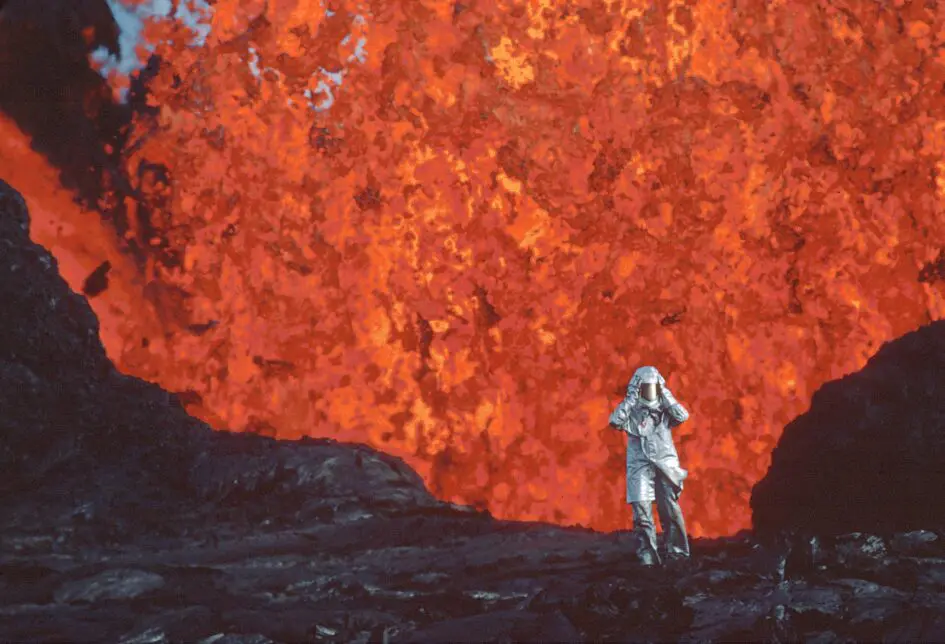Per Matt
There’s obvious symbolism in play when depicting a romantic relationship alongside volcanos. For one thing, these ruptures of Earth’s crust are some of the most powerful and unpredictable forces of nature on the whole planet. Same with relationships. There are the hot flashes that can make you weak in the knees if you get too close to their eruptions. Similar reaction if there’s any jealousy issues, whatsoever. And if the plate tectonics ever collide, prepare for some fireworks. Same for clashes in personalities.
Now that I’ve set up some violent similarities between the two topics, I’m happy to report that many of those clashes weren’t interpersonal in Fire of Love, a Neon-National Geographic Documentary Films collaboration. They did appear courtesy of mother nature, though.
This film depicts the lives of Katia and Maurice Krafft, probably the first and only volcanologist couple in the world. Through archive footage, the French scientists (she’s the geochemist, he’s the geologist) meet, fall in love and get married, all while researching their first loves.
“You fall hard for what you know. Harder for what you don’t.”
The Kraffts’ relationship isn’t the only topic at hand. They spent decades learning what makes the planet’s heartbeat and blood flow, along with seeking answers as to what incites an eruption, since each volcano has a unique personality. Through their research, they classified volcanos (which is used today) into two groups, depicting their eruptions: Red (divergent plate boundaries) and Gray (convergent plate boundaries).
Many times, their research was a solitary event, other times they’d recruit others for assistance. But always, they’d travel with their cameras, as photography and home videos were a means of remembering, revisiting and studying. Surprisingly, these videos hold up today, although I’m sure some were given the HD treatment.
This power couple lived life on the edge — literally. At times, it looks unreal as they walk up to lava flows without wearing much protective gear, but I noted a couple of times Maruice foreshadowed his own death, as he realizes volcanos would eventually be the death of him, but he never seemed to care. Each one considered volcanos as their home and the unknown was not something to be feared, but something to embrace.
I could go on and on about how much I enjoy nature documentaries — and this one in particular — but I’ll try to sum it up with this. The Kraffts’ “science of observation” wound up really expanding the study of plate tectonics, since there weren’t very many volcanologists around when they initially started. And their calls for a warning system and evacuation plans to be implemented whenever activity intensifies has actually saved thousands of people’s lives throughout the years.
I will admit to being intrigued by Maurice’s dream of boating down a stream of lava. While he was absolutely adventurous and a little too carefree in the face of limitless destruction, he did get to canoe in a lake of acid, which seemed like a very bad idea at the time. His preference of living an intense, short life to a monotonous, long one proved prescient as he and Katia didn’t survive the eruption of Japan’s Mount Unzen in 1991.
Finally, Sara Dosa deserves a lot of credit, since the multi-hyphenate is listed in the credits as the writer-director-producer, among others. She’s a one-woman army who had to take a very deep dive through the Kraffts’ archive in order to assemble this film. And the hard work has paid off, as the film has won an editing award at the 2022 Sundance Film Festival, as well as honors by the Online Film Critics Society, the Critic’s Choice Documentary Awards and the Directors Guild of America Awards.
The untamed elements of volcanos, as well as love, can be unpredictable at times, but the Kraffts gave their all in the name of science, just like Dosa gives her all as a filmmaker. Both should be commended for their intense efforts.
